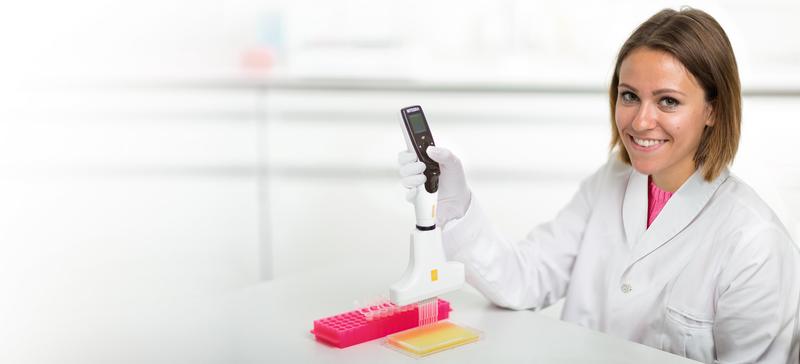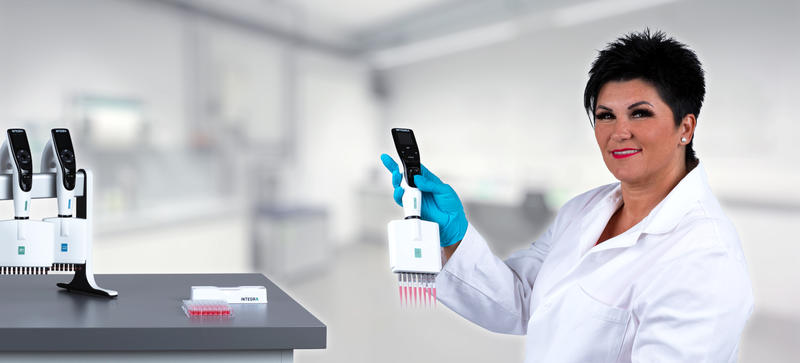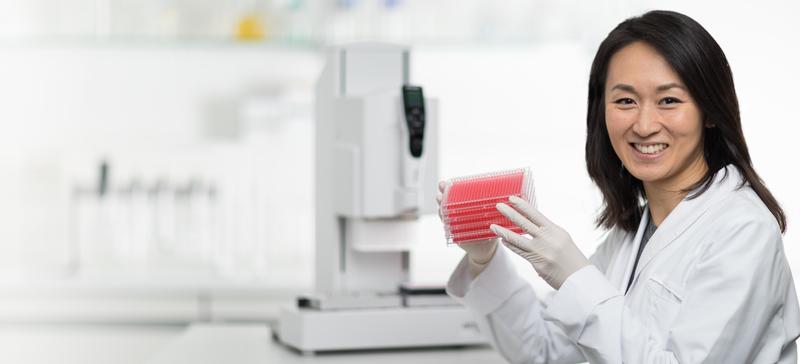-
MTT assay for cell proliferation, viability and cytotoxicity with the ASSIST PLUS pipetting robot
Automated sample preparation on the ASSIST PLUS for a rapid colorimetric assay measuring cell metabolic activity
The MTT cell proliferation assay, first described by Mosmann¹, is a commonly used colorimetric assay for assessing cellular metabolic activity. This broadly used, rapid and quantitative cell-based assay can be used to measure cell proliferation, cytotoxicity or cell activation for a variety of cell types. The test is based on the reduction of yellow tetrazolium salt (MTT) to purple formazan crystals by metabolically active cells; viable cells contain NADH-dependent oxidoreductase enzymes which reduce the MTT to formazan. The insoluble crystals are dissolved using a solubilization solution with the darker the color of the resulting solution, the greater the number of metabolically active cells.
-
Table of contents
The MTT cell proliferation assay, first described by Mosmann¹, is a commonly used colorimetric assay for assessing cellular metabolic activity. This broadly used, rapid and quantitative cell-based assay can be used to measure cell proliferation, cytotoxicity or cell activation for a variety of cell types. The test is based on the reduction of yellow tetrazolium salt (MTT) to purple formazan crystals by metabolically active cells; viable cells contain NADH-dependent oxidoreductase enzymes which reduce the MTT to formazan. The insoluble crystals are dissolved using a solubilization solution with the darker the color of the resulting solution, the greater the number of metabolically active cells.
Key benefits
- Automating the assay expands sample throughput, maximizes intra- and inter-assay reproducibility as the program is always executed in the same way, and increases walk-away time.
- The compact footprint of the ASSIST PLUS pipetting robot allows processing in a laminar flow cabinet, guaranteeing sterile working conditions.
- The automated process protects the user from toxic fumes by minimizing contact with reagents.
- The use of INTEGRA's divided reagent reservoirs with SureFlo™ anti-sealing array together with Low Retention GRIPTIPS® allows efficient handling of precious reagents like MTT or cell culture medium with expensive additives.
Overview: How to automate the MTT assay
The ASSIST PLUS, together with a VOYAGER 8 channel 125 μl adjustable tip spacing electronic pipette with 125 μl Sterile, Filter, Low retention GRIPTIPS, is used to automate the pipetting steps of the MTT cell proliferation, viability and cytotoxicity assay, guiding the user whenever manual intervention is required during the process.
Prior to starting the assay, 5 mg/ml MTT stock solution with sterile PBS (pH 7.4) should be freshly prepared. Dimethyl sulfoxide (DMSO) is needed to dissolve the formazan crystals. The cells of interest should be seeded at a concentration of 10⁴-10⁵ cells per well in 100 μl of cell culture medium.
Tip: A concentration using fewer cells per well may also be sufficient if very highly proliferating cells are used. However, it is crucial that every well has the same number of cells initially, and replicates and controls should be used. Before the assay, cells should be incubated with the compound to be tested.
The workflow is split across two days. Accordingly, the protocol is divided into two programs that guide the user through the steps of the assay and automate the pipetting steps.
- Program 1: Cell incubation with fresh cell culture medium (Cell_incubation)
- Program 2: Automated MTT assay (MTT_assay)
Downloads: Automated MTT assay protocols and reports for ASSIST PLUS
Here you can download the complete protocols and reports used in this application and use them on your ASSIST PLUS. The protocol can be customized with the VIALAB software.
Experimental set-up: Day 1 – Program 1 – Cell incubation with fresh cell culture medium
|
Deck position A: |
Empty |
|
Deck position B: |
Dual reservoir adapter containing two 25 ml multichannel reagent reservoirs with SureFlo anti-sealing array. |
| Deck position C: |
INTEGRA slanted plate holder (20°) (Figure 1) with the seeded cells in a 96 well flat bottom plate (Greiner Bio-One International GmbH, Figure 2, green). |
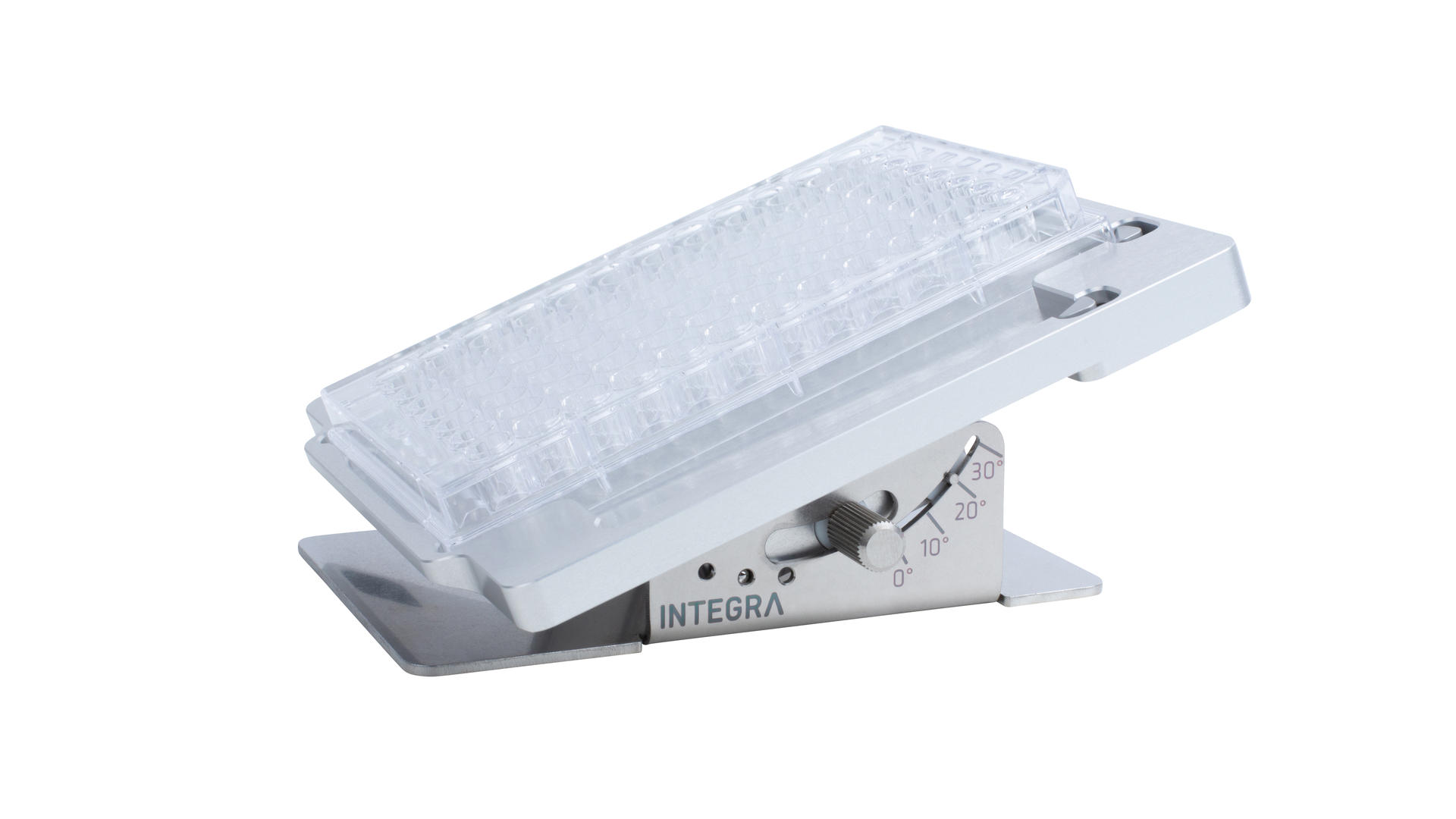
Step-by-step procedure
1. Cell incubation with fresh cell culture medium
Changing cell culture medium before incubation
Load a 25 ml multichannel reservoir onto the left compartment of the dual reservoir adapter and fill with 12 ml of fresh cell culture medium. Place an empty 25 ml multichannel reagent reservoir on the right side of the adapter. Adjust the tilt on the slanted plate holder to 20° by loosening the screw manually, tilting to the 20° indication and tightening the screw again. Place the 96 well flat bottom plate with seeded cells onto the slanted plate holder on deck position C (Figure 2). The plate position on the INTEGRA slanted plate holder helps gentle dispensing and complete aspiration of liquids (Figure 3).
Select and run the VIALAB program 'Cell_incubation' on the VOYAGER pipette. The pipette removes 100 μl of cell culture medium from each well in column 1, then replaces it with 100 μl fresh medium from the reservoir. This exchange continues column-by-column until the cell culture medium in every well of the entire 96 well plate has been replaced. The process is performed column-by-column to avoid cell drying. Once the pipetting steps are complete, the VIALAB program informs the user to incubate the 96 well plate overnight at 37 °C with 5 % CO2.
Tips:
- The ASSIST PLUS has a special Cabinet Mode that enables easier installation and control of the pipettes. The pipette holder lowers at the beginning and at the end of the program for easier navigation.
- Pipetting speed can also be altered to aspirate the cell culture medium from the 96 well plate very slowly, avoiding shearing stress to the cells.
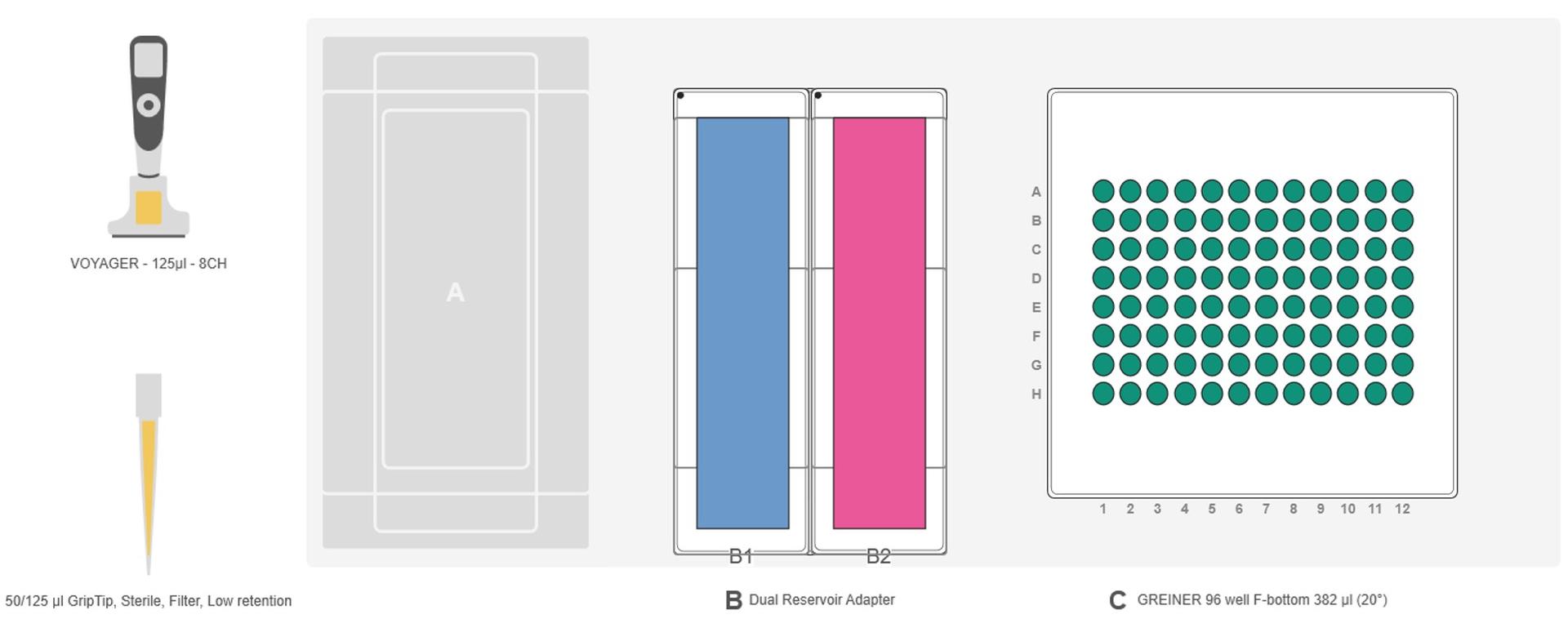

Experimental set-up: Day 2 – Program 2 – Automated MTT assay
|
Deck position A: |
Dual reservoir adapter containing a 25 ml divided reagent reservoir and a 25 ml multichannel reagent reservoir with SureFlo anti-sealing array. |
|
Deck position B: |
150 ml automation friendly reagent reservoir with SureFlo anti-sealing array. |
| Deck position C: |
INTEGRA slanted plate holder (20°) with the seeded cells in a 96 well flat bottom plate (Figure 4, purple). |
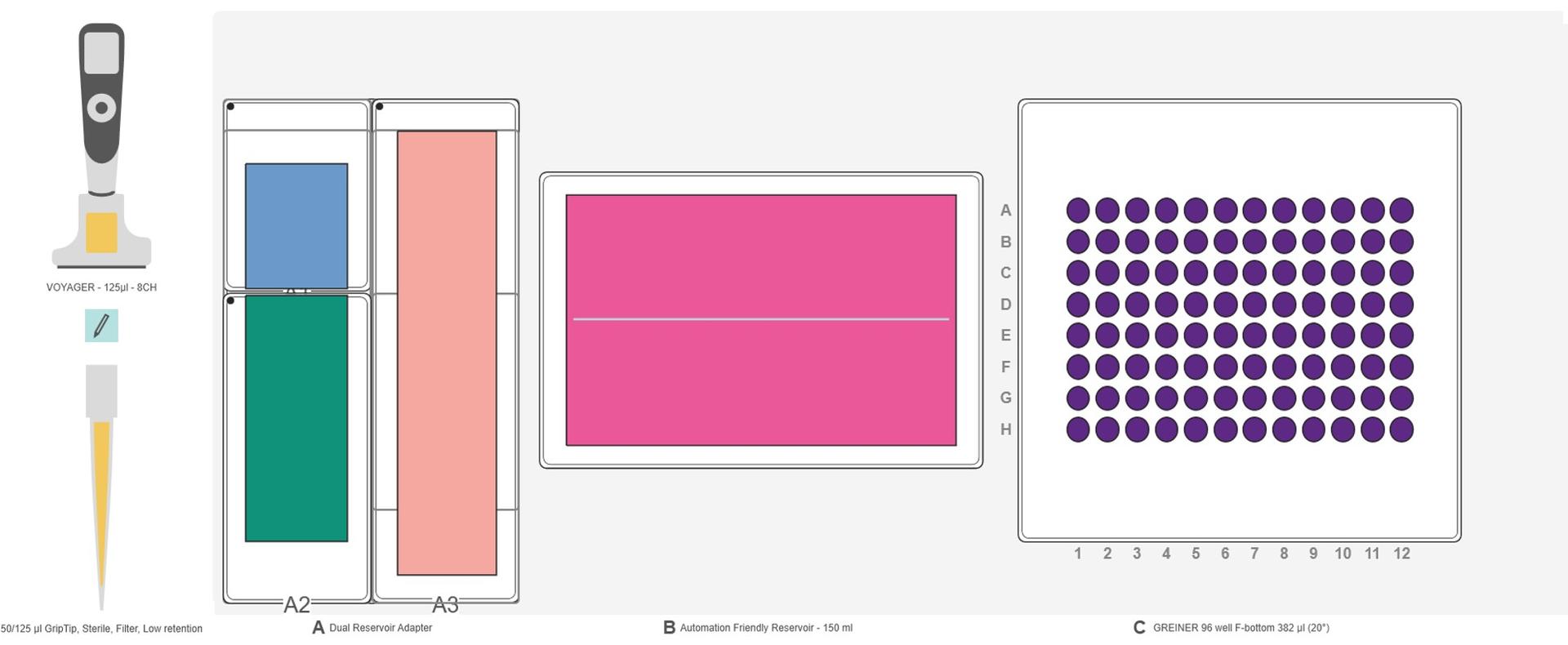
Step-by-step procedure
1. Cell washing
Washing the cells with fresh cell culture medium
Fill the 5 ml compartment of the divided reagent reservoir (blue) with 1.5 ml MTT stock solution (5 mg/ml) and the 10 ml compartment (green) with 10 ml of fresh cell culture medium. Place an empty 150 ml automation friendly reagent reservoir on deck position B to collect the liquid waste and the 96 well plate with the seeded cells on the slanted plate holder (20°) on deck position C (Figure 4). Select and run the VIALAB program 'MTT_assay' on the VOYAGER pipette. In this first step, the ASSIST PLUS pipetting robot exchanges the old cell culture medium for fresh medium. 100 μl of old medium is slowly aspirated from each well of the 96 well plate and replaced with fresh medium from the 10 ml compartment of the divided reagent reservoir.
Tips:
- The cell washing step can also be done with sterile PBS.
- Disposable sterile filter tips allow for contamination-free cell culture processing.
- Using Low Retention GRIPTIPS is optimal when pipetting liquids that contain proteins as they ensure the greatest liquid recovery in comparison with standard tips.
2. MTT addition and incubation
Adding MTT solution and incubating the cells to generate formazan crystals
The VOYAGER pipette adds 10 μl MTT solution to each well using Repeat Dispense mode. The ASSIST PLUS pipetting robot prompts the user to incubate the 96 well plate for 2-6 hours at 37 °C with 5 % CO2.
Tips:
- The ASSIST PLUS pipetting robot can be paused at this step for the duration of the incubation or stopped. In the latter case, the VIALAB program 'MTT assay' should be continued from step 28 after the incubation.
- Using the 25 ml divided reagent reservoir with SureFlo anti-sealing array allows a very low dead volume and minimizes the loss of expensive reagents.
3. Dissolving formazan crystals
Removing the cell culture medium containing residual MTT and dissolving the formazan crystals in DMSO
Fill the 25 ml reagent reservoir (Figure 4, light pink) with 11 ml DMSO. After incubation, when the purple formazan crystals are formed, the VOYAGER pipette carefully removes the cell culture medium containing residual MTT, slowly aspirating 110 μl from the 96 well plate and transferring it to the automation friendly reagent reservoir (Figure 4, magenta). Next, DMSO is added using the ‘Repeat Dispense’ mode and mixed thoroughly with the crystals.
Tips:
- During removal of the cell culture medium containing residual MTT, the aspiration speed is set to 2 to avoid disturbing the crystals. After the addition of DMSO, the mixing conditions (height, speed, cycle and volume) are optimized to allow complete dissolution.
- Water-soluble tetrazolium dyes (e.g. XTT, MTS, WSTs) can also be used instead of MTT. In these cases, there is no need for dissolution in DMSO.
4. Incubation and plate reading
Incubation for complete dissolution of formazan crystals and results read-out
The ASSIST PLUS pipetting robot prompts the user to incubate the 96 well plate for 10 minutes at room temperature with 5 % CO2. In the next step, the ASSIST PLUS pipetting robot alerts the user to read the results with a microplate reader at 570 nm (MTT) and 690 nm (for reference).
Tips:
- If dissolution of the formazan crystals is incomplete, incubate the plate overnight at 37 °C.
- If a dye other than MTT is used, absorbance should be measured at the corresponding wavelength according to the supplier's recommendation.
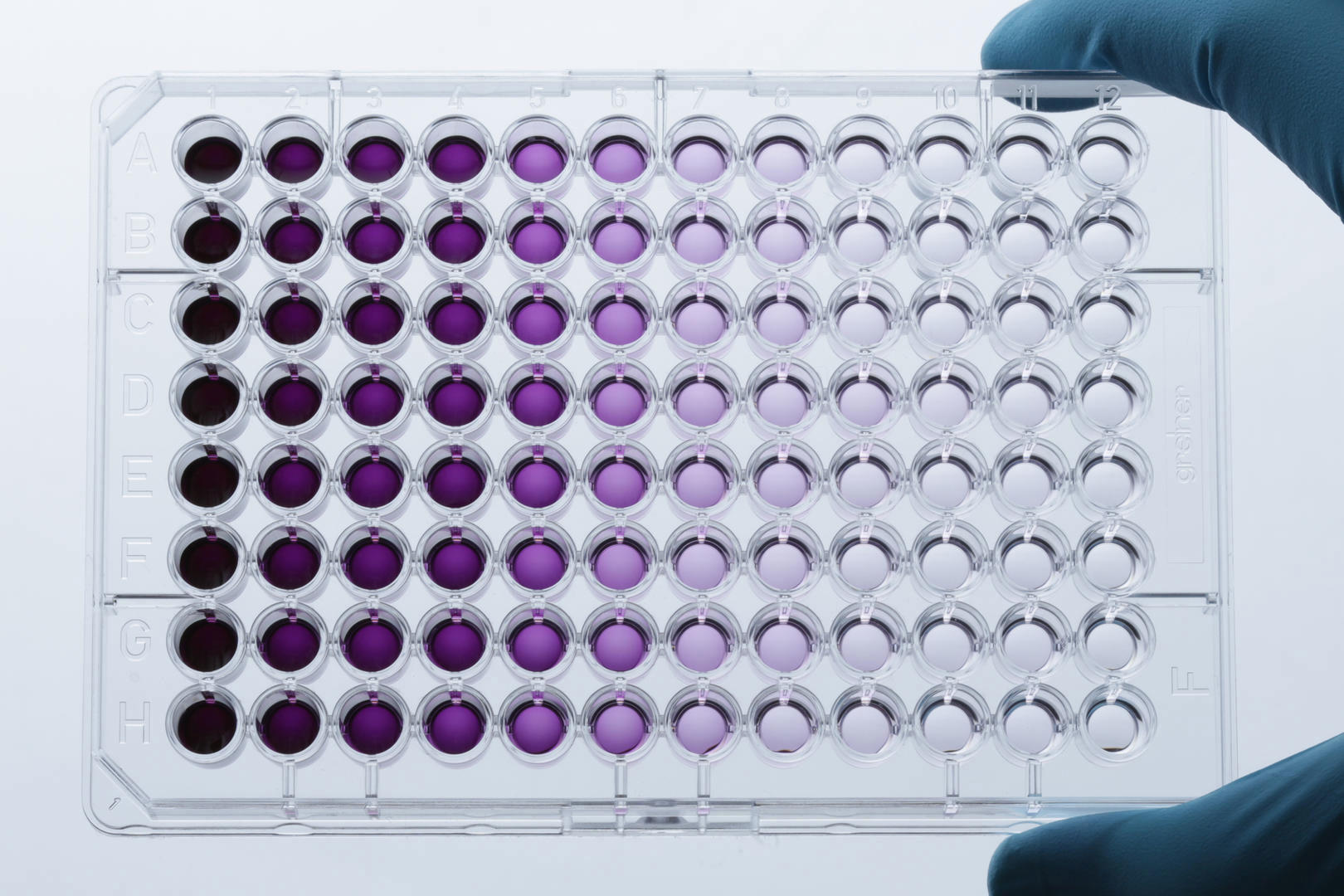
Remarks
VIALAB software:
The VIALAB program can easily be adapted to fit the user’s specific labware and protocols.
Partial plates:
Programs can be adapted at any time to a different number of samples, giving laboratories total flexibility to meet current and future demands.
Conclusion
- Measurement of cell viability is widely used in estimating general cell health, assessing responses to toxic conditions, testing of drugs or screening active compounds. Conducting the MTT assay with the ASSIST PLUS pipetting robot offers a simple, fast, cost-effective and automated solution for assessing cellular metabolic activity.
- The small footprint of the affordable ASSIST PLUS pipetting robot means that it can easily be placed under a laminar flow cabinet, ensuring sterile working conditions.
- This assay is very flexible and can be easily adapted to user's needs. Changing the pipette allows the user to process plate formats other than 96 wells. Plates with 12-384 wells can also be processed on the ASSIST PLUS pipetting robot.
- Automated tip changes avoid any assay contamination, while using ‘Repeat Dispense’ and ‘Multi Aspirate’ modes whenever possible speeds up the process.
- Prolonged manual pipetting tasks lead to repetitive strain injury. This can be avoided by automating these steps with the ASSIST PLUS pipetting robot, maximizing hands-free time.
Related articles
Further reading: An introduction to cell culture and its challenges
Ask our expert. Leave a comment!
Write us if you have any questions regarding the application note or one of our instruments.
Any questions? I'm happy to help!
Instruments and accessories
ASSIST PLUS, Pipetting Robot
INTEGRA has developed the ASSIST PLUS pipetting robot to streamline routine pipetting tasks at an affordable price. Using INTEGRA electronic multichannel pipettes, the system:
- automates pipetting tasks,
- eliminates physical strain and
- ensures superior reproducibility and
- error free pipetting.
Part No. 4505
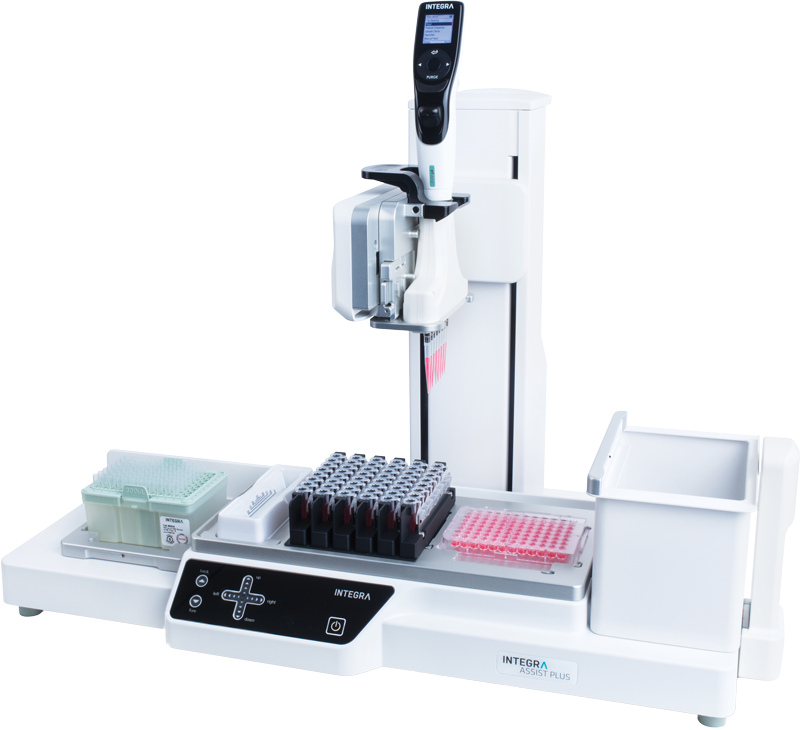
VOYAGER, 8 Channel, 125 µl
VOYAGER pipettes allow the tip spacing to expand anywhere between 4.5 mm and 33 mm at the push of a button.
- Single handed operation leaves the other hand free to handle labware.
- On the fly access to up to 3 user-defined tip spacings.
- These user defined tip spacings are saved. No need to memorize spacings of different labware formats.
Part No. 4722
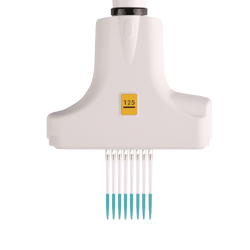
Dual Reservoir Adapter
The dual reservoir adapter makes this system ideal for assays that required sequential addition of several low volume reagent mixes. This adapter holds two 10 ml, 25 ml or divided reagent reservoirs side by side in an aluminum frame, and can be pre-chilled to keep reagents cool during processing.
Part No. 4547
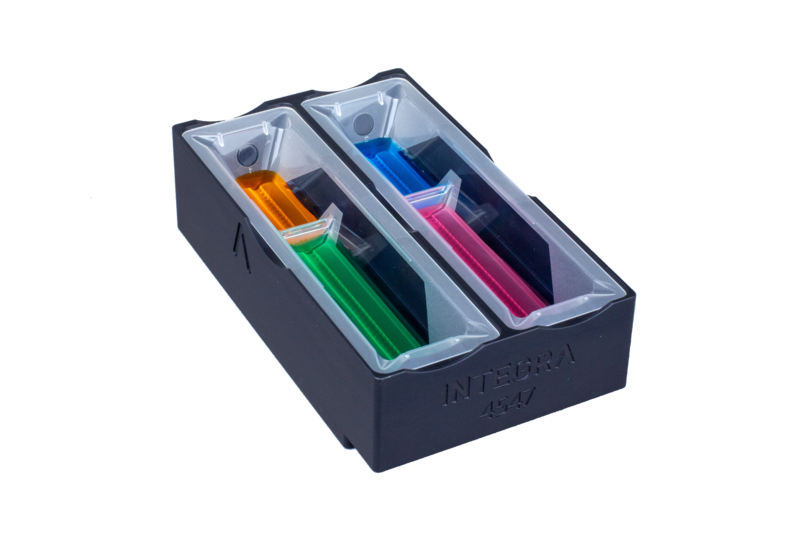
Slanted plate holder (0°-30°)
The slanted plate holder can tilt microplates at angles of 10°, 20° or 30°, allowing users to aspirate media or supernatant from the plate while minimizing dead volumes.
Part No. 4510
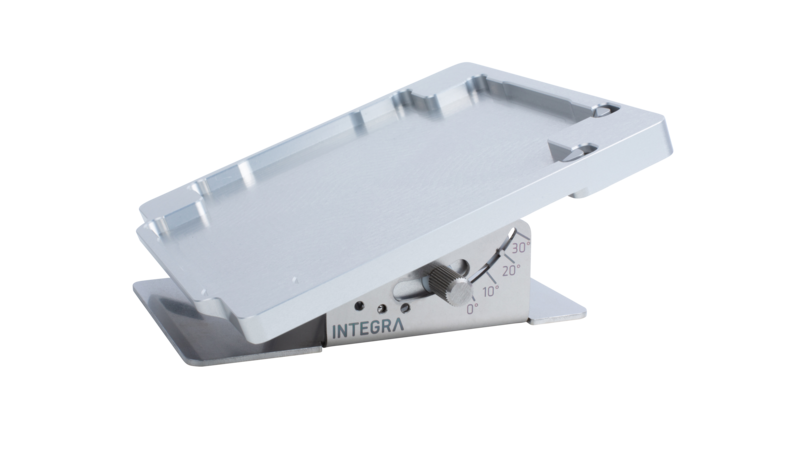
GRIPTIPS®, 125 µl, Sterile, Filter, Low retention
INTEGRA uses a unique polypropylene blend to mold Low Retention GRIPTIPS® with heightened hydrophobic properties. Using Low Retention GRIPTIPS® prevents low surface tension samples from spreading out and “wetting” the inner wall of the tips, allowing them to bead-up for a maximum liquid recovery.
Part No. 6565
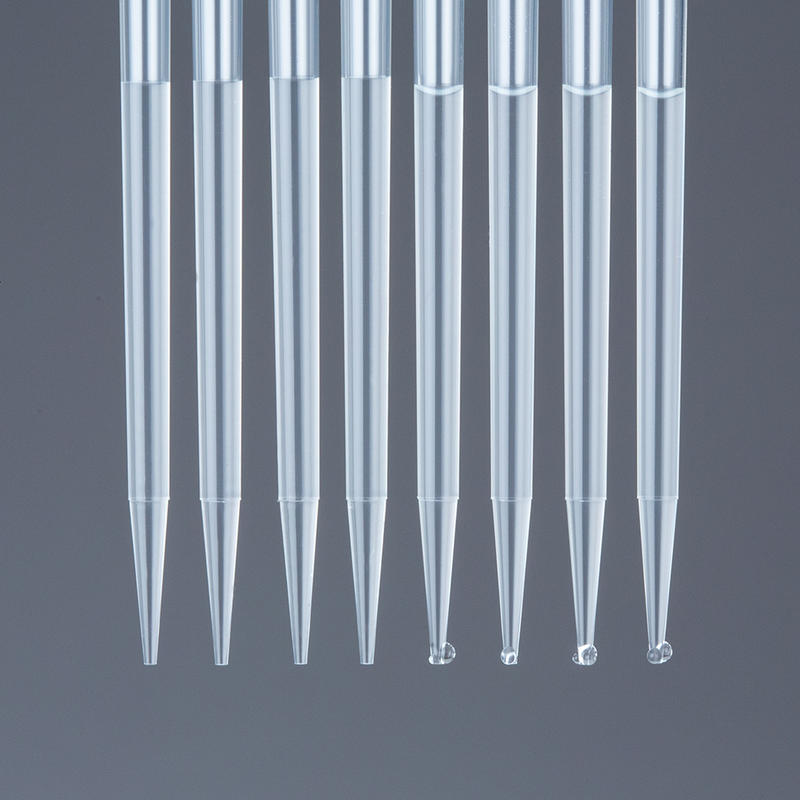
Multichannel Reagent Reservoir, 25 ml
- SureFlo™ anti-sealing array prevents pipette tip seal off which can cause liquid to pop into the tip, filter or even the pipette itself
- Unique surface treatment spreads liquid evenly offering even lower dead volumes
- Reusable base with bold, crisp, clearly visible graduation markings
- Nest inside each other, making it possible to get twice as many reservoirs in half the space of other products on the market
- Reducing inventory space requirements and shipping costs
- Available as crystal clear polystyrene reservoirs or polypropylene reservoirs for improved chemical compatibility
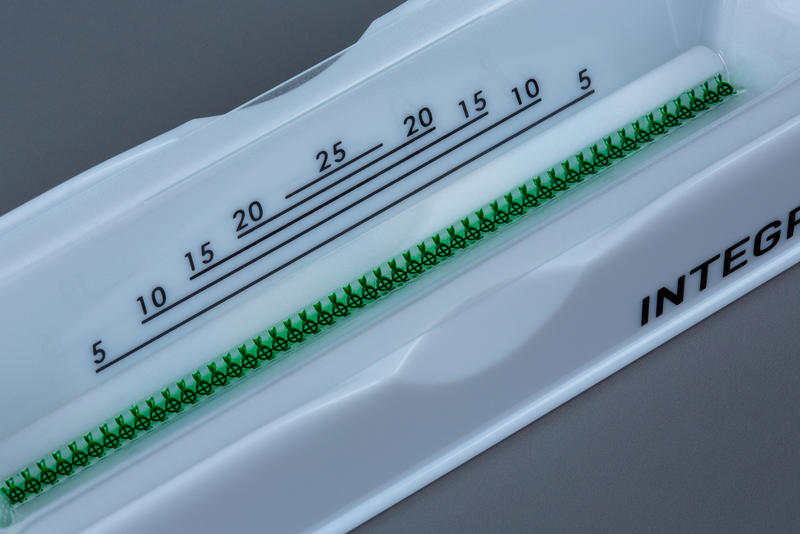
Automation Friendly Reagent Reservoirs, 150 ml
150 ml Automation Friendly Clear Advantage™ Reservoirs (Polystyrene) which are made of crystal clear 100 % virgin polystyrene and fit into a reusable automation friendly base with bold, crisp, clearly visible graduation markings.
The SureFlo™ Array located on the flat bottom reservoir prevents pipette tip seal off. This allows users to rest the pipette tips directly on the bottom of the reservoir offering an incredibly low dead volume of less than 3 ml!
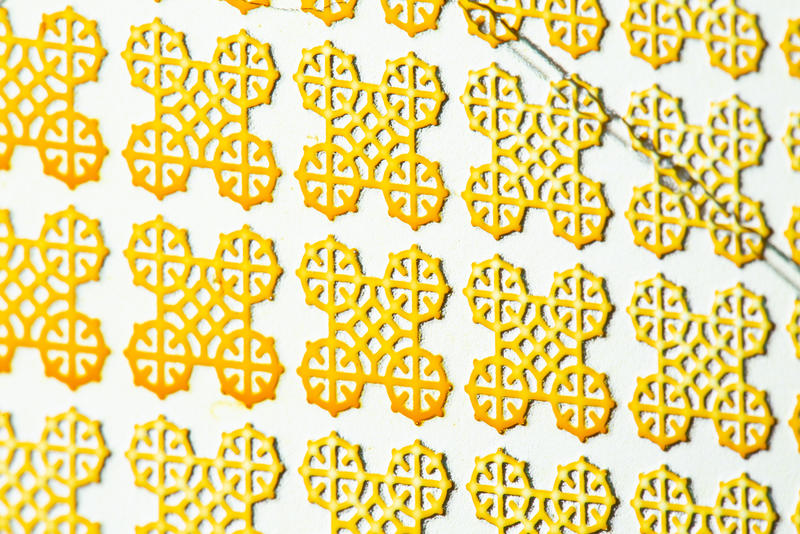
Divided Reagent Reservoir, Sterile, SureFlo anti-sealing array, 25 ml, PS
Lowest Dead Volume On The Market!
25 ml divided reservoirs are comprised of 5 and 10 ml compartments, while still nesting comfortably in the standard 25 ml reusable, sturdy base.
Each reservoir features the SureFlo™ anti-sealing array and hydrophilic surface treatment providing especially low dead volumes.
Part No. 4350, 4351, 4352
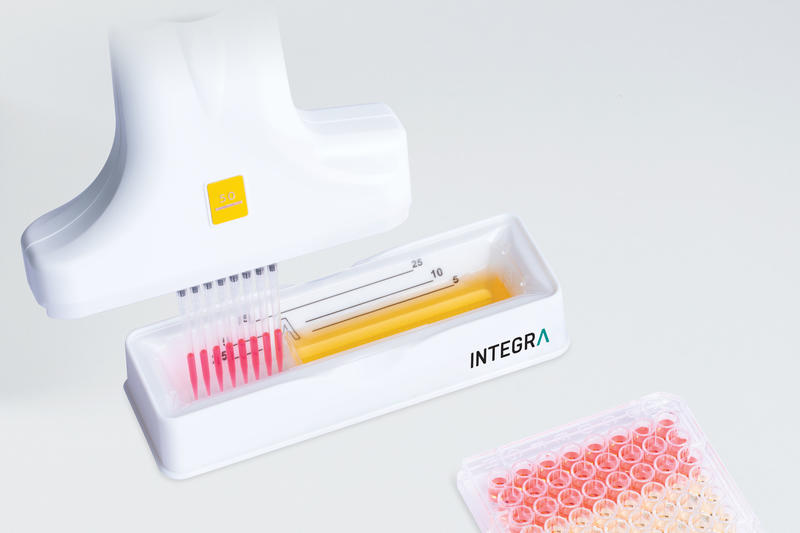
Greiner Bio-One: 96 Well Polypropylene Microplates
SAPPHIRE MICROPLATE, 96 WELL, PP, FOR RT PCR, WHITE, HALF-SKIRT, FOR LIGHT CYCLER, 10 PCS./BOX
Source: Website Greiner Bio One
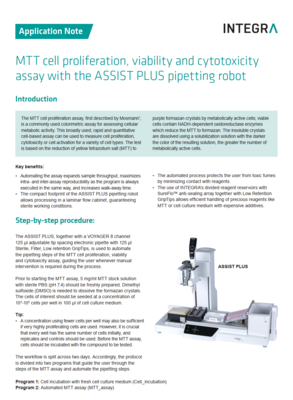
Download
Download App Note as PDF
DownloadMTT assay for cell proliferation, viability and cytotoxicity with the ASSIST PLUS pipetting robotCustomer’s voice
I am incredibly impressed with the hardware, software, and support of this device. The Assist Plus made pipetting large numbers (hundreds to thousands) of small volume reference standards a much easier process, both in terms of ensuring precise volumes every time and in terms of strain on my back/hands! Swapping consumables and vials was all I had to do once the program started. The ViaLab software used to program the Assist Plus was easy to understand and use, requiring no programming knowledge. It was also highly customizable to meet specific needs and use specific consumables. Prior to use, a technician from Integra stopped by to ensure the machine was calibrated properly after installation, and also answered several questions we had about operation. Great support/service. (Review published on Select Science)

